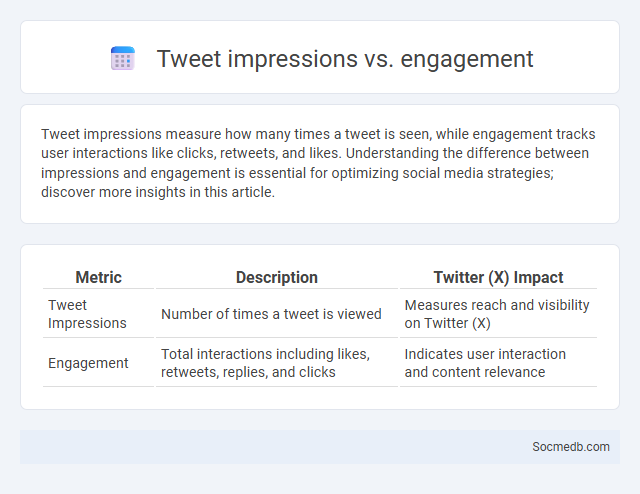
Photo illustration: Tweet impressions vs engagement
Tweet impressions measure how many times a tweet is seen, while engagement tracks user interactions like clicks, retweets, and likes. Understanding the difference between impressions and engagement is essential for optimizing social media strategies; discover more insights in this article.
Table of Comparison
| Metric | Description | Twitter (X) Impact |
|---|---|---|
| Tweet Impressions | Number of times a tweet is viewed | Measures reach and visibility on Twitter (X) |
| Engagement | Total interactions including likes, retweets, replies, and clicks | Indicates user interaction and content relevance |
Understanding Tweet Impressions: What They Really Mean
Tweet impressions represent the total number of times your tweet is displayed on users' timelines, search results, or profiles, reflecting potential reach rather than actual engagement. An impression occurs each time your content appears, regardless of user interaction, distinguishing it from metrics like likes, retweets, or clicks. Understanding this metric helps you gauge the visibility of your message and optimize your social media strategy for broader audience exposure.
Defining Engagement on Twitter: Key Metrics Explained
Engagement on Twitter is measured through key metrics such as likes, retweets, replies, and clicks, which indicate how users interact with your content. These metrics provide insights into your audience's interest, helping you understand the effectiveness of your tweets in driving conversation and visibility. Monitoring these engagement rates is essential for optimizing your social media strategy and increasing your brand's reach on the platform.
Tweet Impressions vs Engagement: Core Differences
Tweet impressions quantify how many times your content appears on users' feeds, reflecting potential reach and visibility. Engagement measures direct interactions such as likes, retweets, replies, and clicks, indicating audience interest and activity with your message. Understanding the core differences between impressions and engagement helps optimize your social media strategy to boost meaningful connections rather than just passive views.
How Twitter Measures Impressions and Engagements
Twitter measures impressions by counting each instance a tweet appears on a user's timeline, search results, or moments, providing insight into the tweet's reach. Engagements include all interactions with the tweet, such as clicks, retweets, replies, follows, and likes, highlighting user interaction levels. These metrics are crucial for analyzing tweet performance and optimizing social media strategies.
Why Impressions Matter in Social Media Analytics
Impressions measure how many times your social media content is displayed, providing a crucial metric for understanding visibility and reach. High impression counts indicate that your posts are frequently seen, increasing brand awareness and potential engagement opportunities. Tracking impressions helps you assess the effectiveness of your content strategy and optimize future campaigns to better connect with your target audience.
Evaluating the Impact: Engagement Rates Demystified
Engagement rates on social media platforms such as Instagram, Twitter, and Facebook serve as critical metrics for assessing content effectiveness and audience interaction. Calculated through likes, comments, shares, and click-through rates, higher engagement rates correlate with improved brand visibility and conversion potential. Understanding engagement rate benchmarks specific to industries and platforms enables marketers to fine-tune strategies and optimize campaign performance efficiently.
The Role of Reports: Analyzing Twitter Performance
Reports analyzing Twitter performance provide crucial insights into engagement metrics such as retweets, likes, and follower growth, enabling marketers to optimize content strategies. Detailed analytics reveal audience demographics, peak activity times, and trending hashtags, helping brands enhance reach and interaction. Continuous monitoring of these reports supports data-driven decisions that improve campaign effectiveness and ROI on Twitter.
Data-Driven Strategies: Improving Impressions & Engagement
Data-driven strategies leverage analytics and consumer insights to optimize social media impressions and engagement effectively. By analyzing metrics such as click-through rates, audience demographics, and peak activity times, your campaigns can be tailored to maximize visibility and user interaction. Applying these targeted tactics ensures higher engagement rates and improves overall social media performance.
Interpreting Twitter Reports: Actionable Insights
Interpreting Twitter reports provides actionable insights by analyzing engagement metrics such as impressions, retweets, and follower growth to identify trending content and audience preferences. Your ability to decode these data points enables targeted marketing strategies and improved content creation. Leveraging sentiment analysis within Twitter data helps you gauge public opinion and optimize communication efforts effectively.
Best Practices for Maximizing Both Impressions and Engagement
Consistent posting schedules and high-quality, visually appealing content drive greater impressions and engagement on social media platforms. Utilizing platform-specific features such as Instagram Stories, Reels, and Twitter Threads enhances visibility and interaction rates. Engaging with followers through comments, polls, and user-generated content fosters community loyalty and amplifies organic reach.
 socmedb.com
socmedb.com